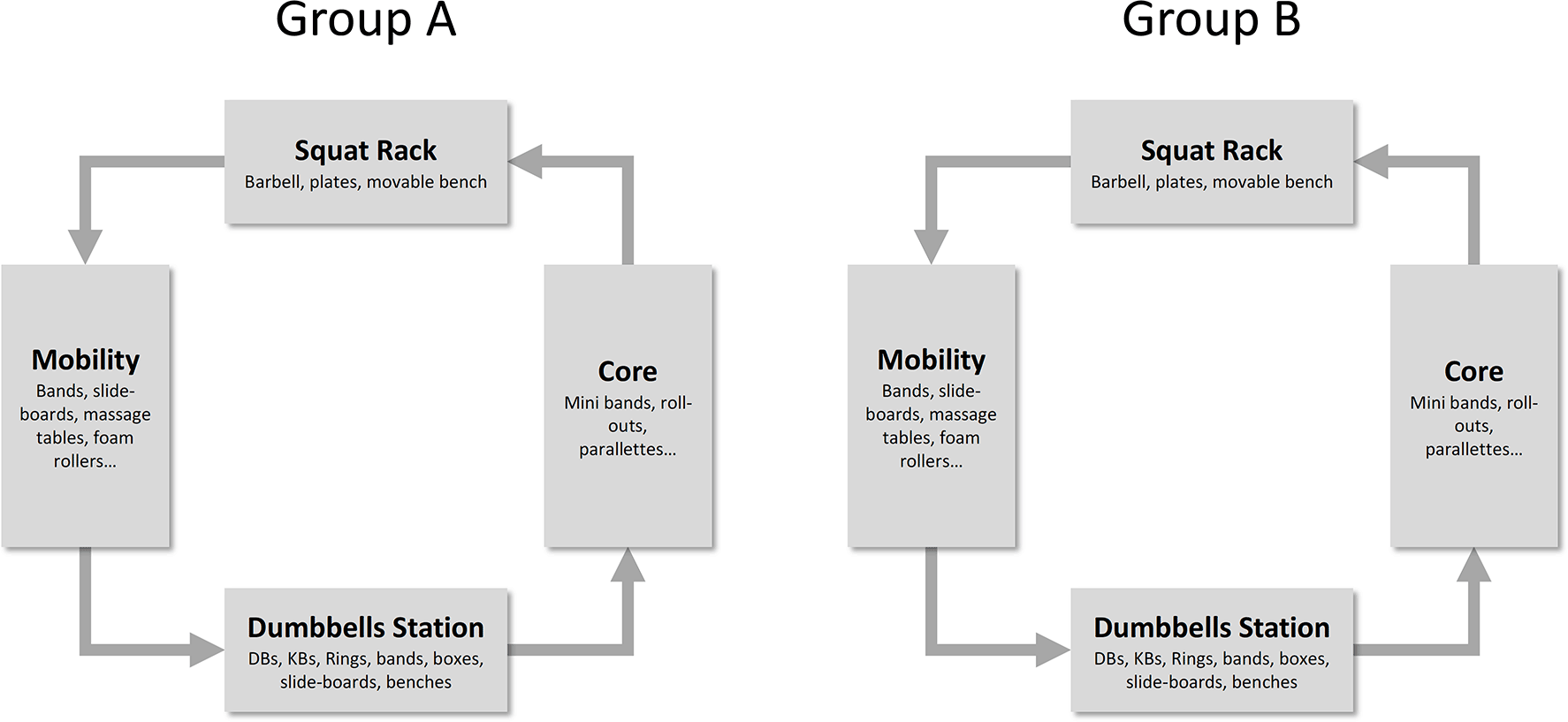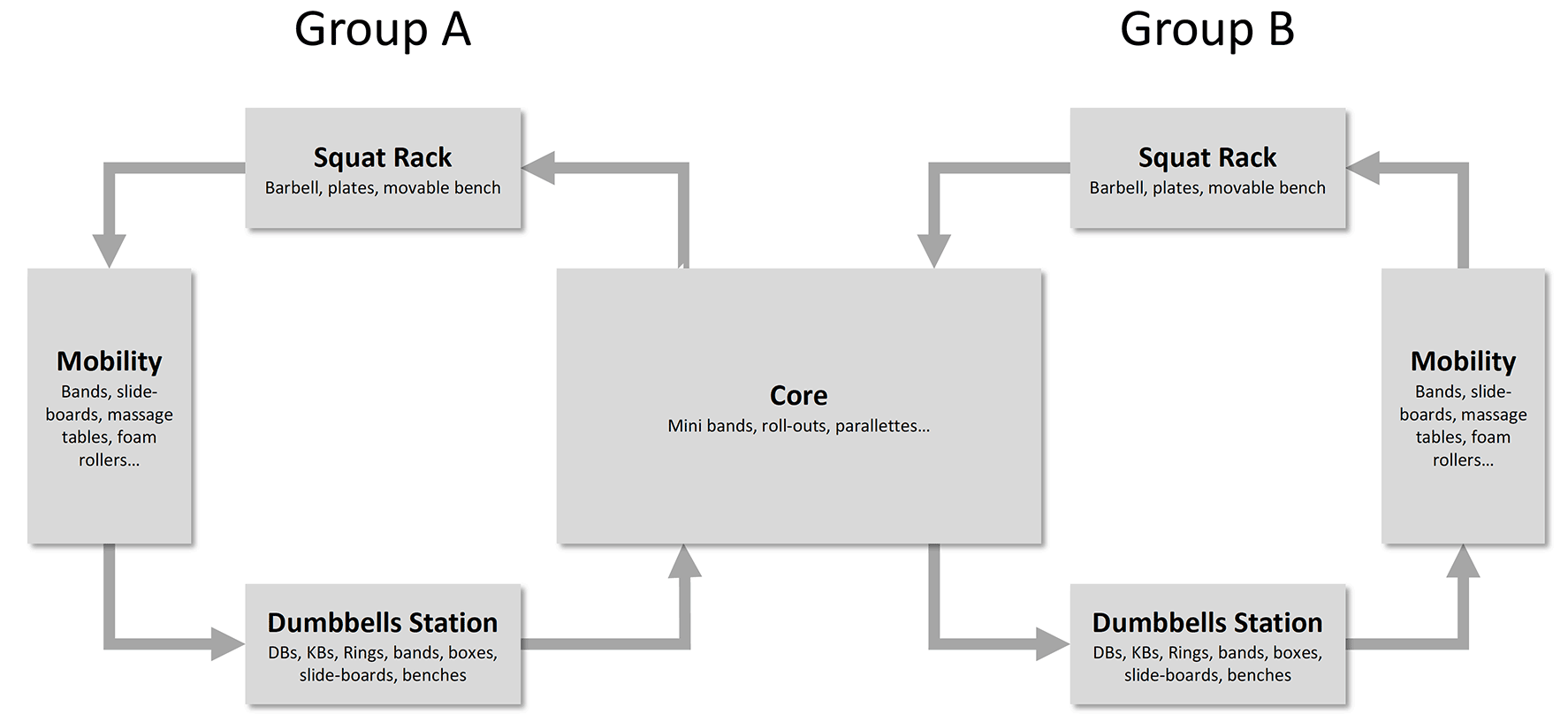Circuits, Combos, and Complexes – Part 2
Objectives and Load Selection
Circuits have gotten some bad rep, mostly due to (1) soccer players fucking-around and doing 15-30sec circuits using some random exercises in the gym, and (2) due to Crossfit WODs. Both seem to be pulled straight out of arse with the single aim of making athletes tired. As alluded to in this article, circuits do not need to be solely done as a finisher and metabolic conditioning with the aim of leaving athletes in the pond of sweat. Organizational circuits (see Part 1 are perfectly fine way to organize large number of athlete in the gym using the limited equipment, regardless of the strength specialists bitching about those and circuits overall (strength specialist program are often done in blocks of single exercise only). As coaches we need to be adaptable and suit the exercise prescription to the types of athletes we have in front of us, objectives, as well as constraints, such as available equipment or coaching presence (e.g., if you are a single coach with 30+ athletes).
Table 1 contains some of the applications of the circuits.
| Application | Description and recomended loading |
|---|---|
| Warm-up | Full body circuit done for 5-10 reps, far away from failure. The goal is to raise up the body temperature, practice certain movements, warm-up the joints, etc |
| Organizational Circuits | Use circuits/super-sets and fillers to avoid bottle-necks. This also allows for modular design in which certain circuit elements are ‘for all,’ and some are ‘individualized’ |
| Skill | Practice tasks/problems organized in circuit manner provides an implementation of the varied and random practice, which is better for skill retention than blocked practice |
| Explosiveness | Ballistic or Explosive circuits, and most notably weightlifting complexes. Low number if reps, quality and speed of movement must be maintained. In the Explosive circuits there needs to be no rush to finish the exercises. This can often be fulfiled by adding filler exercises (e.g., mobility, core, stabilizers, etc) |
| Strength | Circuits can be used to build strength as well (i.e., see organizational circuits). For complexes keep the number of exercises low, lower number of reps (i.e., less than 5, with >70% 1RM), might alternate between upper/lower movements to avoid accumulating fatigue |
| Hypertrophy | Similar to strength circuits, but slighlty higher number of reps (e.g., 5-10, with 55-75% 1RM) to accumulate more volume. Movements that hit the same muscle/movement pattern can be grouped |
| Local muscular endurance | Multiple exercises hitting the same muscle/movement pattern, done with high number of repetitions (e.g., 15-20+). Isolation movement are also fine. These can also be organized using time intervals with break |
| Metabolic conditioning / Finisher | Multiple exercises alternating hitting different muscle/movement patterns, done with high number of repetitions (e.g., 10-15+). Compound movements moslty |
| Prehab-Rehab | Various exercises targeting stabilizers, or using slow movements and isometrics |
| Robust planning | Utilizing circuits to easily target all non-target movement patterns, resulting in robust training (i.e., training that is robust to missing sessions) |
Table 1: Suggested applications of the circuits and recommended loading
Please note, that although I have enlisted developing strength and muscle mass (and other objectives) with circuits/complexes in the Table 1, we are not going to use them if there are better options available (i.e., normal training sets). These should be approached as tools in the toolbox, which we can use for certain scenarios. These scenarios include, but are not limited to, (1) large groups and lack of equipment, (2) being time-crunched, (3) the need for variations in training (e.g., pivot blocks), (4) creating a workout outside of the normal training location, for example, while being on vacation and using hotel gym, or being in the curfew during the COVID19 pandemic.
Warm-up circuits
Let me take a quote on warm-ups from the Strength Training Manual, Volume One and Two:
Similarly to the discussion on active recovery means and methods in the previous chapter, I approach warm-ups differently. Rather than looking at warm-up as means to reach the working temperature of the body and priming the nervous system only, one can look at warm-up as an affordance to practice and develop particular quality at the current state of the organism. I know this is a mouthful, but it simply means addressing what can be addressed while the athlete is warming up. During the warm-up, one can perform and address different qualities that can be addressed at that particular state. For example, one might perform Vanilla training, like rehab, mobility, pre-hab, core, stabilization, and so forth, as well as practice the main movement.
Long story short, we can use the warm-up to address certain qualities while the body is warming up. Circuits and complexes are excellent tools for this. We are not going to do only circuits and complexes in the warm-up phase of the session, but they can be a major element, for example:
1. Foam Roll and Breathing drills if needed (e.g. someone coming after work through city rush hour)
2. Ground Mobility
3. Core
4. Kettlebell or Bodyweight Circuit/Complexes
Table 2 contains example warm-up circuits and kettlebell complex that can be used as a general warm-up. To avoid unnecessary burn in the muscles, it is wise to alternate between upper/lower and push/pull movements. The number of reps is around 5-15 (depending on the exercise) and done far away from failure. If multiple circuits are used, reps can drop and weight can be increased.
| Warm-up Circuit | Warm-up KB Complex |
|---|---|
| Goblet Squats | Slings |
| Push-Ups | RDL |
| Back Extension | Halos |
| Rings Inverted Rows | Marching |
| Side Bridge | Goblet Squat |
| Hip Prehab | Press |
| Shoulder Prehab | Lateral Squat |
| Bent-Over Row | |
| Knees Up | |
| Push Ups | |
| Single Leg RDL | |
| Swings |
Table 2: Warm-up circuit and KB complex example
Organizational Circuits
As already outlined in Part 1 of this article, circuits can be used for organizational purpose (especially if we consider super-sets as mini-circuit). The theme of these circuits can be warming-up, skill work, explosive work, strength work, rehab, or mixed (e.g., contrast jumps/throws as mini-circuit). As explained in Volume One and Two of the Strength Training Manual 1, these organizational circuits (termed functional units) can be used to organize groups of individuals inside the training facility (see Figures 1 and 2). This is very useful when we want to avoid equipment bottlenecks (or waiting queues) and maintain the flow in the gym.

Figure 1: Functional units. Gyms are usually organized around the squat rack

Figure 2: Functional units with shared area/equipment
These functional units can become organizational slots (or simply stations) – instead of using top-down planning, we are using bottom-up planning and organizing around what we have at our disposal. Table 3 contains examples of two organizational circuits built around functional units.
| Station/Slot | Circuit A | Circuit B |
|---|---|---|
| Squat Rack Station | Split Squat | Bench Press |
| Mobility Station | Lat Stretch | Hip Stretch |
| DBs/KBs Station | KB Press | SL RDL |
| Core Station | Roll-out | Pallof Press |
Table 3: Organizational circuits based on the equipment and functional unit constraints
Organizational circuits can be expanded from functional units to a whole workout organization. Depending on the throughput (to use this industrial-age/Taylorism term) of the athletes in the gym, the whole gym (and hence the workout) can be organized to increase the flow of the athletes and reduce the potential bottleneck. We can call these organizational blocks.
1. Enter the facility
2. Change clothes
3. Pre-workout supplements
4. Prehab
5. Warm-up
6. Speed/Agility/Quickness
7. Power (Jumps, Olympic lifts)
8. Strength Training Circuit A
9. Strength Training Circuit B
10. Conditioning
11. Post-workout supplements
12. Shower and change clothes
13. Exit the building
The whole gym can be organized based on these expected stages. Figures 3 and 4 depict two hypothetical gym organizations based on the expected workout stages.











Responses